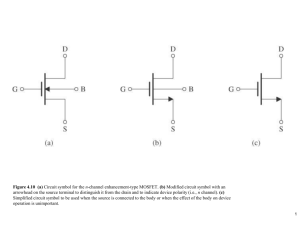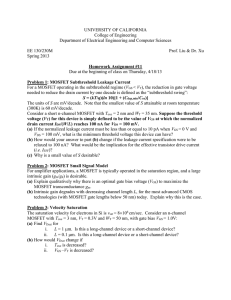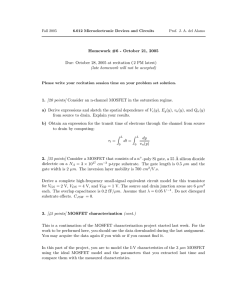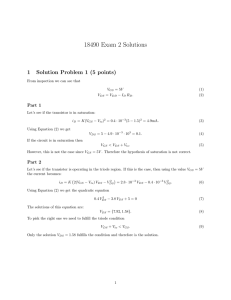EE 40: Introduction to Microelectronic Circuits Spring 2008: HW 10
advertisement
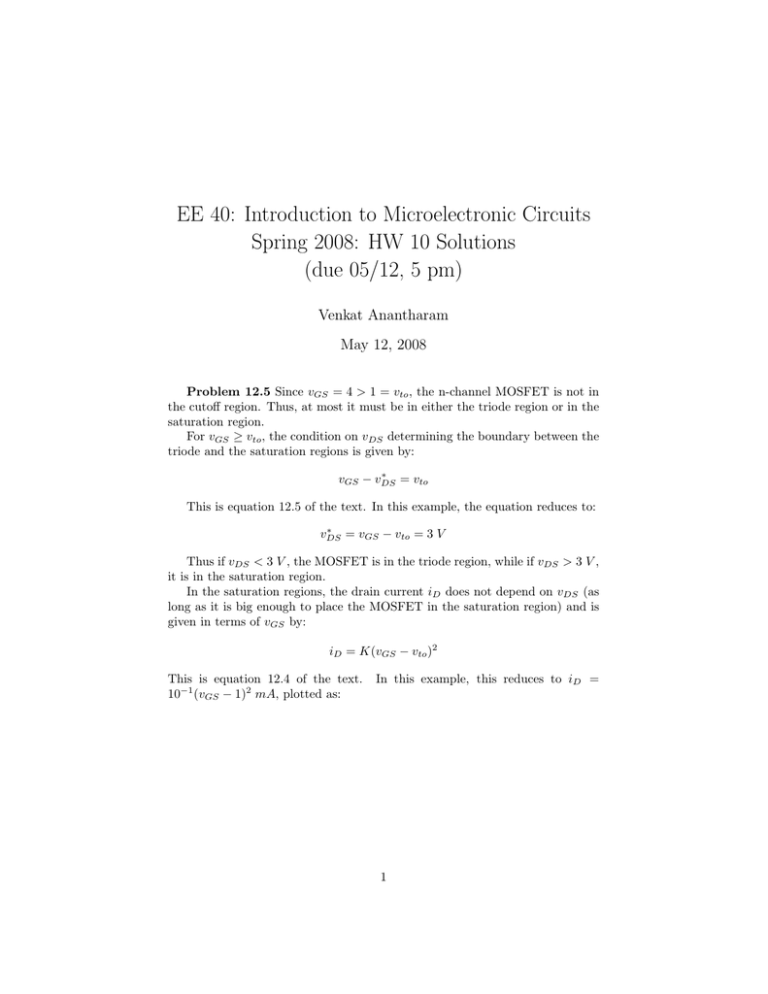
EE 40: Introduction to Microelectronic Circuits Spring 2008: HW 10 Solutions (due 05/12, 5 pm) Venkat Anantharam May 12, 2008 Problem 12.5 Since vGS = 4 > 1 = vto , the n-channel MOSFET is not in the cutoff region. Thus, at most it must be in either the triode region or in the saturation region. For vGS ≥ vto , the condition on vDS determining the boundary between the triode and the saturation regions is given by: ∗ vGS − vDS = vto This is equation 12.5 of the text. In this example, the equation reduces to: ∗ vDS = vGS − vto = 3 V Thus if vDS < 3 V , the MOSFET is in the triode region, while if vDS > 3 V , it is in the saturation region. In the saturation regions, the drain current iD does not depend on vDS (as long as it is big enough to place the MOSFET in the saturation region) and is given in terms of vGS by: iD = K(vGS − vto )2 This is equation 12.4 of the text. 10−1 (vGS − 1)2 mA, plotted as: In this example, this reduces to iD = 1 Problem 12.8 Part (a) This is an n-channel MOSFET. The body has been tied to the source. From the figure, we have vGS = 4 V and vDS = 5 V . Also, the parameters |Vto | and k are given. Since this is an n-channel MOSFET we know that Vto > 0. Here, vto = 1V . Since vGS = 4 > 1 = vto , the MOSFET is not in the cutoff region. The boundary between triode and saturation regions is defined by: ∗ vGS − vDS = vto ∗ ∗ i.e..by vDS = vGS − vto = 3V . Since vDS = 5 > 3 = vDS the MOSFET is in the saturation regions. The drain current (here denoted by IQ ) is then given by: IQ = K(vGS − vto )2 = 0.1(4 − 1)2 = 0.9 mA. Part (b) This is a p-channel MOSFET (which explains why the terminals are labelled as shown, given that the total drop from the top terminal to the bottom terminal is positive). The body has been tied to the source. Here, we have: vGS = −3V 2 and vDS = −4V . Also, we have vto < 0 because this is a p-channel MOSFET. Since vGS = −3 < −1 = vto , the MOSFET is not in the cutoff region. THe boundary between the triode and saturation regions is given by: ∗ vGS − vDS = vto ∗ ∗ , the MOSFET is in the = −2 V . Since vDS = −4 < −2 = vDS i.e..by vDS saturation region. Thus the drain current (here denoted by Ib ) is given by: Ib = k(vGS − vto )2 = = 0.1(−2)2 0.4 mA Part (c) This is a p-channel MOSFET. The terminals have been labelled as shown using the information and nothing that the voltage drop from the top to the bottom terminal is positive. The body has been tied to the source. Here, we have: vGS = −5 V and vDS = −1 V . Also, we have vto < 0. Since vGS = −5 < −1 = vto , the MOSFET is not in the cutoff region. The boundary between the triode and saturation regions is given by: ∗ vDS = vGS − vto = −4 V ∗ Since vDS = −1 > −4 = vDS , the MOSFET is in the triode region. The drain current (here denoted by Ic ) is then given by: Ic 2 = K(2 ∗ (vGS − vto )vDS − vDS ) 3 = 0.1 ∗ (2(−4)(−1) − (−1)2 ) = 0.1 ∗ 7 = 0.7 mA Part (d) This is an n-channel MOSFET. The body has been tied to the source. We have: vGS = 3 V and vDS = 1 V . Also, we know that vto > 0. Here we have vGS = 3 > 1 = vto so the MOSFET is not in the cutoff region. The boundary between the triode and saturation is given by ∗ vDS = vGS − vto = 2 V Since ∗ vDS = 1 < 2 = vDS the MOSFET is in the triode region. We then have the drain current (denoted by Id ) given by: Id 2 = K(2 ∗ (vGS − vto )vDS − vDS ) = 0.1(2 ∗ (2.1 − 1)) = 0.3 mA Problem 12.14 This is an n-channel MOSFET. The body has been tied to the source. The voltages at the gate and drain are referred to ground. Since the drain current is 0.5 mA, the same current goes from source to ground. So the 4 voltage drop across the resistor is 0.5R, where R is measured in kΩ. From the figure, we then conclude that: vGS = 3 − 0.5R volts and vDS = 5 − 0.5R volts. Since the drain current is strictly positive, the MOSFET is not in the cutoff region. This gives the equation: 3 − 0.5R = vGS ≥ vto = 1 i.e..3 − 1 ≥ 0.5R. Thus, R ≤ 4kΩ. The boundary between the triode and the saturation regions is given by: ∗ vDS = vGS − vto = = (3 − 0.5R) − 1 2 − 0.5R ∗ Since vDS = 5−0.5R > 2−0.5R = vDS , we can conclude that the MOSFET is in the saturation region. You should be somewhat careful here and observe that we also have vDS ≥ 0, so the drain and source have indeed been properly labelled (actually this is already obvious given the direction of the drain current). The drain current equation in the saturation region can be brought into play. This gives: 0.5 − iD = K(vGS − vto )2 = 0.5((3 − 0.5R) − 1)2 = 0.5(2 − 0.5R)2 From this we conclude that: 2 − 0.5R = 1 or 2 − 0.5R = −1 That is, R = 2 kΩ or R = 6 kΩ Since we already know that R ≤ 4 kΩ, we can conclude that R = 2 kΩ. 5 Problem 12.20 Part (a) The DC equivalent circuit is given below. By the voltage divider principle, 300 · 20 = 3 V . The AC equivalent circuit is the DC component of vGS is: 2000 shown below. Since no current is drawn at the gate irrespective of what regime the transistor is operating in, the AC component of vGS is sin(2000πt). We conclude that: vGS (t) = 3 + sin(2000πt) volts Part (b), (c) and (d) 6 Problem 12.30 The parameters are: VDD = 15 V, R1 = 2 M Ω, R2 = 1 M Ω, RS = 4.7 kΩ, RD = 4.7 kΩ, vto = 1 V, k = 0.25 mA/V 2 . Replacing the gate bias circuit by its Thevenin equivalent, we get the figure shown below. The bias-line (see figure 12.14 of the text) is the constraint relating IDQ to VGSQ given by writing KVL 7 around the gate-source loop and it is: 5 = VGSQ + 4.7 ∗ IDQ where VGSQ in volts and IDQ is in mA. This is because no current is drawn at the gate. The drain current in saturation is given in terms of VGSR by: IDQ = K(VGSQ − Vto )2 = 0.25 ∗ (VGSQ − 1)2 Plugging in for IDQ in terms of VGSQ from the bias line gives: (5 − VGSQ ) = 1.175 ∗ (VGSQ − 1)2 i.e.. 47 2 47 47 V + (1 − )VGSQ + ( − 5) = 0 40 GSQ 20 40 i.e.. 2 47VGSQ − 54VGSQ − 153 = 0 Solving the above equation, we get VGSQ = −1.3 V and VGSQ = 2.5 V . We can obviously ignore the negative solution and we thus get VGSQ = 2.5 V . This gives IDQ is approx. 0.56 mA. So VDQ is approx. 10 > 2.5 − 1 confirming that the MOSFET is in saturation. Problem 12.35 1 The parameters for the first MOSFET are vto = 0.5 V, kp = 100µA/V 2 , W L1 = 1. Since no current is drawn at the gate of the second MOSFET irrespective of what regime it is operating in, it does not load the first MOSFET. Thus we can analyze each MOSFET in isolation. From the parameters given, we compute: K=( W kp ) = 50µA/V 2 = 0.05mA/V 2 L 2 If iD1 = 0.2 mA, we would have: vDS = vGS = 5 − 0.2R 8 where R is measured in kΩ. Since the drain current is strictly positive, it must be the case that the MOSFET is not in cutoff. Therefore, we must have: 5 − 0.2R ≥ 0.5 i.e.. R ≤ 22.5 kΩ Since vDS = vGS > vGS − vto , the MOSFET would be in the saturation region, giving the equation: iD1 = K(vGS − vto )2 0.2 = 0.05((5 − 0.2R) − 0.5)2 = 0.05(4.5 − 0.2R)2 This tells us that either 2 = 4.5−0.2R or −2 = 4.5−0.2R. That is, R = 12.5 kΩ or R = 32.5 kΩ. Since we already know that R ≤ 22.5 kΩ, it must be that R = 12.5 kΩ. This then gives: vDS = 5 − 0.2 ∗ 12.5 = 2.5 V Turning now to the second MOSFET, we can draw the corresponding circuit as shown. Here we have labelled the terminals using tildes to distinguish them from the terminals of the first MOSFET. We have also observed that the gate to source voltage of the second MOSFET equals the drain to source voltage of the first MOSFET,i.e..2.5 V . For the second MOSFET, we have vto = 0.5 V . Thus the second MOSFET will be in saturation precisely when vx ≥ 2.5 − 0.5 = 2 V . For the second MOSFET, we have: K̃ = ( W2 kp ) = 0.1mA/V 2 L2 2 iD2 = K̃(2.5 − 0.5)2 This gives: = = (0.1)4 0.4 mA 9 The second transistor appears to be ”equivalent” to an ideal current source if one assumes that it is operating in saturation. Problem 12.46 You should first of all realize that even the signal values given are necessarily approximate, since there would have to be some distortion in iD (t) in a real MOSFET (even given the equations we are working with) when vGS (t) has a purely sinusoidal AC component. The given data corresponds to: vGSQ = 1, vDSQ = 4 and IDQ = 2 while vgs (t) = 0.2sin(ωt), vds (t) = 0 and id (t) = 0.1sin(ωt) Since there is no AC part in the drain to source voltage we cannot estimate rd . However, we can estimate gm as: gm = 0.1 = 0.5 millimhos (sounds like Austin P owers) 0.2 Problem 12.51 The DC equivalent circuit which determines the quiescent point values is shown below. The parameters are kp = 0.05 mA/V 2 , W = 600 µm, L = 20 µm, vto = 2 V and rd = ∞. We have VGSQ = 3 V , from the resistive voltage divider formula. Since, vGSQ = 3 > 2 = vto the transistor is not in cutoff at the quiescent point. The load line to determine the quiescent point value is given by KVL: 20 = IDQ ∗ R + VDSQ We compute: K=( 0.05 W kp ) = 30 = 0.75 mA/V 2 L 2 2 10 The boundary between the triode region and the saturation region occurs for ∗ VGSQ = 3 at VDS = VGSQ − vto = 3 − 2 = 1 V . The corresponding current ∗ ∗ on the load line would be ID = 20 − VDS = 19 mA. The saturation current at VGSQ = 3 V is: K ∗ (VGSQ − vto )2 = 0.75 ∗ 3.22 = 0.75 mA ∗ which is less thatn ID . Thus the MOSFET is in saturation at the quiescent point and we have IDQ = 0.75 mA. Further, VDSQ = 20 − 0.75 = 19.25 volts. We may use equation (12.24) on page 590 of the text to write: p p gm = 2 (KIDQ ) = 2 (0.752 ) = 1.5 mV Part (b) The AC equivalent (small signal) circuit is: Since RL = 1 kΩ and vgs (t) = vin (t), the voltage gain is: Av = −gm 1 = −0.75 2 11 The input resistance is found by looking into the circuit across the AC voltage source and ground when the load is replaced by an open circuit. Here this is the parallel combination of 1.7 M Ω and 300 kΩ, which is 255 kΩ. The output resistance is found by looking into the circuit across the load terminals as shown below (when the input voltage source is replaced by a short circuit). Here vgs = 0, so the controlled current source may be replaced by an open circuit. The output resistance is thus seen equal to 1 kΩ. Problem 12.55 From formula (12.42) for the voltage gain of the source follower, we see that it can never exceed 1 in absolute value whereas from formula (12.35) for the voltage gain of the common-source amplifier we see that it could, in principle, exceed 1. Thus we would need to choose a common-source amplifier if we desire a voltage gain greater than 1 in absolute value. Consider formula (12.37) for the output resistance of the common-source amplifier. Note that rd is typically very large (and often modelled by ∞). Next consider formula (12.45) for the output resistance of the source follower. Note that if gm is large, then this can be quite small. This suggests that the source follower is a better configuration to choose for an amplifier if we desire a small output resistance. Problem 12.57 The parameters for the circuit are: kp = 0.05 mA/V 2 , W = 600 µm, L = 12 10 µm, vto = 1 V, rd = ∞, VDD = 15 V, VSS = 15 V . We first compute kp 2 K = (W L ) 2 = 1.5 mA/V . Part (a) To find the Q-point, consider the DC equivalent circuit. If the MOS- FET in this DC equivalent circuit were in the cutoff region, we would have IDQ = 0. This would imply that VGSQ = 15 V . But this exceeds vto , contradicting our assumption. Thus we must have IDQ > 0 and the MOSFET is not in cutoff. We have: VGSQ = 15 − 3IDQ where IDQ is measured in mA and VGSQ is measured in volts. Also, VDSQ = 30 − 6IDQ Bot these equations result from KVL. Since VDSQ = 2VGSQ ≥ VGSQ −vto , where the second equation comes from VGSQ ≥ vto , we know that the MOSFET is in the saturation region at the Q-point. This gives the equation: IDQ = K(VGSQ − vto )2 = 1.5((15 − 3IDQ ) − 1)2 = 1.5(14 − 3IDQ )2 . Solving: IDQ = 4.114 mA, VDSQ = 5.316 V, gm = 4.968 mS, RL = 2.308 kΩ, Av = 11.465 Rin = 188.6 Ω 13
